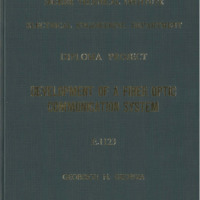Development of a fiber optic communication system
- Τίτλος
-
Development of a fiber optic communication system
- Θέμα
- Telecommunication systems--Design and construction
- Fiber optics
- Δημιουργός
-
Georgiou, Georgia N.
- Πηγή
- Higher Technical Institute
- Το πλήρες κείμενο είναι διαθέσιμο από το Υπουργείο Ενέργειας, Εμπορίου Βιομηχανίας και Τουρισμού.
- Εκδότης
- Library of Cyprus University of Technology
- Ημερομηνία
- 1998
- Συνεισφέρων
- Lambrianides, D.
- Δικαιώματα
- Απαγορεύεται η δημοσίευση ή αναπαραγωγή, ηλεκτρονική ή άλλη χωρίς τη γραπτή συγκατάθεση του δημιουργού και κάτοχου των πνευματικών δικαιωμάτων.
- Μορφή
- Γλώσσα
- en
- Τύπος
- text
- Αναγνωριστικό
-
EED0504
- Σύνοψη
-
Sound (and Data) can be transmitted into digital signal that is encoded into light. On the communication superhighway, pulsing light generated by lasers carries messages on strands of
glass, called optical fiber. In the following project it would be stated why optical fiber is
superior for transmission, how it works and where it is used.
Light carries information in much the same way the electronics systems carry
information. First the sound of your voice is translated into a digital signal by the use of an
analog to digital converter. Then this signal is coded into light. The smallest bit of information
in a digital system is a bit or a binary digit. In light systems, the presence or absence of a pulse
of light communicates a bit of information.
Fiber Optic cables transects over the land while undersea fiber optic cables cross the
oceans. The capacity offiber optic systems continually increases. In 1980, the first systems
could transmit 4SMbps. Today highest capacity systems transmit 5Gbps. The different types of
Fiber optic communication systems are described in part A.
Fiber optics Cables can transmit more telephone calls than coaxial cables microwave
radio or satellite. Electrical signals travel faster at higher frequencies in optical cables and they
can carry more than one set of these signals. Fiber optic networks have replaced
transcontinental copper cable networks and entirely new networks are continually being
created. The copper cables role in today's life is only for electrical installations because they
need more protection and they are being replaced by the fiber optic cables (which their need of
protection is either minimal or not necessary at all).
Fiber optic cables themselves must be connected to some kind of network in order to be
capable to transfer any kind of information in this astonishing ways. That kinds of networks
that are analyzed in Part B and some methods in order to protected them.
To test an existing fiber optic communication system using the fiber optic educator is
analysis in Part C
- Πολυμέσα
-
 EED0504.pdf
EED0504.pdf


